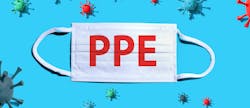Pre-empting pre-treatment in the OR not CSSD’s preference, nor industry standard
Among those administratively, clinically, financially and operationally associated with healthcare procedures, most acknowledge that pre-treating surgical devices and instruments once a procedure is completed makes logical sense.
Of course, those in the Operating Room (OR)/Surgical Services department may find some disagreement with those in Central Sterile Services Department (CSSD) over the simple issue of accountability, responsibility and timing – namely, who’s supposed to do it when, as in how quickly or soon after a procedure is finished.
Historically, CSSD adapted and dealt with the OR sending down post-surgical devices and instruments soiled with crusty bioburden and solidified organic and inorganic material left behind that could have been removed rather easily and quickly in the OR before transport to CSSD for sterile processing.
Then last year the American National Standards Institute (ANSI) and the Association for the Advancement of Medical Instrumentation (AAMI) issued guidelines – the revised ANSI/AAMI ST91:2021 standards – that generated more clarity where there was opaqueness. [See “Responsibility, accountability for pre-treating soiled devices finds a home,” https://www.hpnonline.com/sterile-processing/article/21283933/responsibility-accountability-for-pretreating-soiled-devices-finds-a-home]
Per the joint ANSI/AAMI guideline, the gauntlet was thrown down: Pre-treating surgical devices and instruments is to occur in the OR (a k a at the point of use) right after a procedure and before those products are transported to CSSD for cleaning, decontamination and high-level disinfection or sterilization. To make it more acceptable in the OR, ANSI/AAMI even changed the name to “pre-treating” from “pre-cleaning.”
Case closed? Not exactly. Considerable ruffled feathers around attitude and behavioral modification, collaboration and cooperation linger. The question remains why this practice of pre-treatment at the point of use isn’t universally accepted, adopted and implemented by now as standard practice – if anything else, because ANSI and AAMI say so and the Association of perioperative Registered Nurses (AORN) and the Healthcare Sterile Processing Association (HSPA) agree?
Education and incentives may be the ignition to act, sterile processing experts indicate.
The village needs a roadmap
History shows that dictates and mandates may be effective at changing behaviors (versus attitudes), but education and incentives may accelerate the process, according to clinical experts and executives at companies that make products used for sterile processing.
“The greatest incentive is patient safety,” Ward-Fore told Healthcare Purchasing News. “The ability to remove bioburden from instruments becomes more difficult the longer the bioburden remains on the instrument. Not only does it make it harder for SPD/CSS personnel to clean it, but it may also shorten the life of the equipment due to the need for more aggressive cleaning prior to decontamination. This may also slow down processing time, causing instruments to be out of service longer, which can negatively impact the OR and the patients waiting for procedures.”
Ward-Fore refers to well-publicized infection outbreaks linked to improperly cleaned instruments that led to patient harm as motivation for pre-treating early.
“I believe education on patient harm that results from improper cleaning is one way to incentivize staff,” she urged. “If they don’t understand what can happen downstream, they have little incentive to pre-clean appropriately. I sometimes ask staff how they or a loved one would feel if they were harmed by an improperly cleaned instrument. I’ve never had anyone respond they would be okay with that.”
Everyone needs to be involved and on board, according to Ward-Fore.
“Healthcare personnel work in healthcare because they are caring, compassionate people,” she noted. “Most everyone wants to do the right thing. In the OR, I think adding equipment pre-cleaning to a checklist as a reminder might be one way to get it done in a timely manner. There are many moving parts before, during, and after a procedure so checklists that indicate what and who is responsible for performing a specific task are a useful tool. The protocol for pre-cleaning should be driven by all stakeholders so all perspectives are considered.”
“Providing education and training on the importance of pre-treating instruments and devices immediately after a surgical procedure can help change attitudes and behaviors,” Smith insisted. “Not just educating on the steps that are required, but also educating on why the steps are required is critical. This can be in the form of workshops, seminars or regular in-service training sessions.”
Smith also calls for a roadmap to set parameters and priorities and incorporation of tracking technology to assist.
“Developing clear policies and procedures for pre-treatment of instruments and devices can provide a roadmap for OR staff and help ensure consistent practices,” he indicated. “Leading by example, by encouraging OR managers and leading staff to model the desired behaviors, can go a long way to promoting a culture of proper pre-treatment.
“We are all probably familiar with the old proverb, ‘It takes a village to raise a child.’ Well, it takes an entire facility to ensure patient safety,” Smith continued. “Collaboration with the Sterile Processing Department (SPD) can be accomplished by building a strong relationship between the OR and SPD. This can help promote a shared understanding of the importance of proper pre-treatment. Implementing technology, such as bar-coding systems or automated tracking tools, can help streamline the pre-treatment process and ensure that instruments and devices are being properly pre-treated in a timely manner. Lastly, regularly assessing and improving pre-treatment processes can help ensure that best practices are being followed and that the OR is continuously working towards more efficient and effective pre-treatment protocols.”
“As an infection preventionist, I have found that staff acceptance of appropriate process is imperative to compliance, as are clear parameters for process ownership,” she said. “In addition to maintaining compliance with multiple guideline recommendations, intentionally communicating to the OR staff the importance of their ownership of this step of the process as a patient safety mechanism provides a healthy ‘why’ regarding task ownership and accountability.
“Initiation of the pre-treating step in the OR helps to reduce both the time in which organic and inorganic debris on the instrument or device surface solidifies and the potential for biofilm formation – thus reducing the overall reprocessing time,” Montejano continued. “Circling back to infection prevention and patient safety, we know that if procedural instruments and reusable devices are not effectively pre-treated, complete sterilization can be compromised, creating an infectious risk to the next patient.”
“In my experience when trying to directly affect attitudes, I find making sure everyone understands why [about] a process needs to be important,” he said. “If a process is seen as unimportant then complying with it seems unimportant as well. One strategy that is worth exploring is internal auditing of point-of-use processes. If the culture of the facility is geared towards data driven initiatives. Internal auditing may provide the numbers to convince leadership in the point of use departments to push for greater compliance.”
Hands across the sterile field
Justifying the need for pre-treatment in the OR immediately following a surgical procedure may be the first step to improve a process, but the next step involves implementing the process change.
That’s where communication follows education, sterile processing experts concur.
“Regular meetings between the SPD and OR can help foster a strong relationship and open communication between the two departments,” Olympus’ Smith recommended. “During these meetings, the two departments can discuss best practices, address any challenges and work together on continuous quality improvement initiatives. Joint training sessions can help ensure that both the OR and SPD staff are well-informed and on the same page about best practices for pre-treatment of instruments and devices. This can help promote a shared understanding of the importance of proper pre-treatment and ensure consistent practices across both departments.”
Smith encourages treating the change as you would any process improvement within a department.
“Creating process improvement teams that include representatives from both the OR and SPD can help ensure that any changes or improvements to pre-treatment protocols are made with input from both departments,” he noted. “Communication is key. Regular feedback and open communication between the OR and SPD can help address any challenges or issues in a timely manner and promote a culture of collaboration and cooperation. Establishing joint performance metrics, such as time to pre-treat instruments and devices or rate of instrument damage, can help ensure that both departments are working towards common goals and that the pre-treatment process is continuously improving. Encouraging staff from the OR and SPD to spend time in each other's departments can help build understanding and empathy between the two groups and promote a culture of collaboration.”
Recruiting infection prevention to assist and support the process change adds clinical credibility and emphasis, according to PDI’s Montejano.
“The inclusion of facility infection prevention to aid with a coordinated and systematic approach to instrument and device re-processing is a key support component to implementation of a new process,” she said. “As is the case when any two (or more) departments are developing a partnership around a new process, communication is key. Where applicable, using the support of best practice guidelines and recommendations (in this case APIC, AAMI, AST, AORN and HSPA) provides credibility to the decisions around workflow and process ownership.”
Healthmark’s Hendee agrees and promotes joint learning as the bridge.
“Joint learning, from a source that is respected by both departments, has the potential to create an impact,” he said. “Since infection preventionists garner respect from all clinical settings and are often the point person during accreditation surveys, they have a perspective that could change attitudes about compliance. Here’s something to consider, one of the overarching themes during a survey is that the facility makes efforts to reduce hospital-acquired infections (HAIs). Surgical site infection (SSIs) are a subset of HAIs. If an IP can get both departments to understand the link between reducing biofilms and better cleaning, and subsequently better HLD and sterilization outcomes, then true importance of the practice can be understood.”
Still, Envista’s Ward-Fore praises the ongoing partnership between CSSD and OR.
“The OR and SPD/CSS generally work together pretty well, from my experience,” she observed. “Since SPD/CSS are the ‘experts’ on instrument cleaning, perhaps they could in-service the responsible OR personnel on the proper pre-cleaning of instruments at point-of-use, explaining the most efficient method so the process doesn’t seem overwhelming to OR personnel. It’s really in SPD/CSS and OR personnel’s best interest to perform this properly. No OR likes to start a case and find dirty instruments, then have to stop everything. No SPD/CSS personnel likes to hear that dirty instruments were found and stopped a patient from receiving care.”
Embedding expertise?
What if, the OR were to allow someone from CSSD to come to the OR to handle pre-treatment procedures or to maintain a CSSD tech within the department akin to the OR materials manager who may handle supply ordering and requisition?
Sterile processing experts express intrigue at the idea but offer mixed opinions on the matter.
“Both departments tend to work pretty lean,” acknowledged Ward-Fore. “To have someone from SPD/CSS enter the OR to perform pre-cleaning seems like a lot to ask. The pre-cleaning process, from what I’ve seen, is not labor-intensive. I guess since the scrub nurse or circulator is already in the room, and is very knowledgeable in handling instruments, I could see them performing pre-cleaning at the end of the case, when things are getting put away. I think it really depends on staffing levels in both departments, case volumes and training.”
Hendee questions the feasibility, too.
“Unfortunately, an SPD Tech would not be able to fully accomplish all that point-of-use treatment entails,” he lamented. “There are aspects of the process, like wiping off gross soil, that are meant to be done as the instruments are passed off the field. Those processes can’t be done by anyone other than the scrub. Potentially, an SPD tech could come in after the case and help apply pre-sprays or place instruments in packs designed to maintain moisture, but if the initial wiping is not performed biofilms may already have begun to form.”
Lingering labor challenges may make such a concept easier conjured up rather than carried out, according to Montejano.
“Departmental and individual employee bandwidth may not allow for this given the current staffing challenges in healthcare,” she said. “This capability will vary based on the facility’s own personnel circumstances, though the cross-training of staff generally benefits process efficiency. We know that turnaround time is precious in both the OR and sterile processing departments. Once instruments are received by CSSD the clock is ticking for efficient turnaround. OR personnel can ultimately improve their own metrics by assisting CSSD with point-of-use pre-treatment. What helps make OR ownership of the pre-treating step feasible is keeping the ‘ask’ simple. Providing product (for the process) that is easy to use and easily accessible may provide a greater acceptance into workflow. Some surface disinfection wipes include an indication within the product instructions for use (IFUs) stating the product may be used to preclean and decontaminate critical or semi-critical medical devices prior to sterilization or high-level disinfection.”
Smith, however, remains optimistic about the possibility.
“It is generally acceptable and feasible for the OR to allow someone from SPD to come to the OR to do pre-treatment of instruments and devices as an OR-based SPD tech,” he noted. “This approach can have several advantages, including:
- Improved efficiency: Having an OR-based SPD tech on hand can help ensure that pre-treatment is done in a timely manner, as soon as the surgical procedure is completed. This can help minimize the risk of instrument damage and ensure that instruments are ready for sterilization as soon as possible.
- Increased understanding: By having an SPD tech physically present in the OR, they can get a better understanding of the surgical procedures and the instruments and devices used, which can help them perform pre-treatment more effectively.
- Improved communication: Having an SPD tech present in the OR can improve communication between the two departments, as they can provide real-time feedback on the pre-treatment process and address any issues in a timely manner.
“Having an OR-based SPD tech can have several benefits and is generally acceptable, but the feasibility of this approach must be evaluated on a case-by-case basis,” Smith added.
Pre-treatment of surgical devices at point of use more than simple process name change
By Seth Hendee
If there is any question that pre-treating instruments before returning them to a Sterile Processing Department (SPD) is a topic in need of discussion, look no farther than the name.
When I started in Sterile Processing, the term used was pre-cleaning. Why does a name change matter? It matters because anyone familiar with the pre-treatment section of their instructions for use (IFUs) and standards guidance on the subject knows, pre-cleaning doesn’t involve any actual cleaning.
Unfortunately, device processors have been stressing the need for pre-treatment of instruments for many years but have been receiving pushback for just as many years.
My first experience with trying to improve OR “pre-cleaning” compliance was met with this statement, “That’s not my job. We don’t clean things in the OR.” Even after pointing out that pre-cleaning was called for in instrument IFUs, we received very limited compliance. This mindset contributed to the terminology change to “pre-treatment.”
Replacing the word cleaning with treatment has allowed the focus to shift to the actual steps being performed. Removing disposable trash from sets, removing gross soil from individual instruments, and maintaining moisture on those same instruments are not cleaning steps, but ways of preparing instruments for cleaning.
The main goals of pre-treatment are protecting instruments from damage and limiting the formation of difficult to remove biofilms. In a world of tight turnovers and lack of extra instrument inventory, a quality pre-treatment program will go a long way to accomplishing both goals. When the SPD cleaning processes are quicker and more effective, both the patient and organization feel the benefit.
Seth Hendee, CSPDT, CFER, CRCST, CIS, CER, CHL, HSPA-approved instructor, serves as clinical education specialist, Healthmark Industries.

Rick Dana Barlow | Senior Editor
Rick Dana Barlow is Senior Editor for Healthcare Purchasing News, an Endeavor Business Media publication. He can be reached at [email protected].









